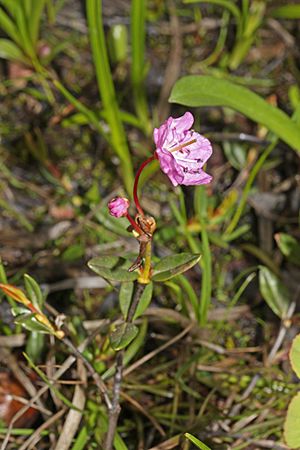List of Ericales of Montana facts for kids
Have you ever wondered about the amazing plants growing in Montana? Among them are many members of a special plant group called Ericales. This group includes plants like heaths, wintergreens, and even some unique ones called monotropes. In Montana, you can find at least 33 different types of Ericales. Some of these plants are native, meaning they have always grown here. Others are exotics or introduced species, which means they were brought to Montana from other places. Some rare Ericales are even called Species of Concern, meaning they need special protection.
Contents
Exploring Ericales: Heaths, Wintergreens, and More
The Ericales order is a large group of flowering plants. It includes many well-known plants like blueberries, cranberries, and rhododendrons. In Montana, you can find a wide variety of these plants. They often grow in cool, damp places.
What Makes Ericales Special?
Many plants in the Ericales group have some interesting features. For example, many of them prefer to grow in acidic soil. This means the soil has a lower pH level. They often have tough, leathery leaves that help them survive in harsh conditions. Some Ericales also have special relationships with fungi in the soil. These fungi help the plants get nutrients.
Many plants in this group produce berries. These berries are often a food source for wildlife. Some, like huckleberries, are also popular for people to eat. The flowers of Ericales can be quite beautiful. They come in many shapes and colors.
Where Do Ericales Grow in Montana?
Ericales plants can be found in many different habitats across Montana. You might see them in dense forests, especially in the mountains. They also thrive in wet areas like bogs and swamps. Some types grow in high alpine meadows, where the conditions are very cold and windy. Their ability to adapt to different environments shows how tough and versatile these plants are.
For example, you might find Arctostaphylos uva-ursi, known as kinnikinnick, growing on dry, rocky slopes. On the other hand, Kalmia microphylla, the alpine bog laurel, prefers very wet, boggy areas.
Important Ericales You Might Know
Montana is home to many interesting Ericales. Here are a few examples you might recognize:
- Kinnikinnick (Arctostaphylos uva-ursi): This is a common groundcover plant. It has small, leathery leaves and bright red berries. It stays green all year round. Many animals eat its berries.
- Huckleberries (Vaccinium membranaceum, Vaccinium scoparium, and others): These are very popular berries in Montana. They are related to blueberries. Huckleberries are a favorite food for bears and people alike. They grow in mountain forests.
- Prince's Pine (Chimaphila umbellata): This plant has shiny, dark green leaves. It produces small, waxy flowers. It often grows on the forest floor.
- Indian-pipe (Monotropa uniflora): This is a very unique plant. It does not have green leaves and does not use sunlight for food. Instead, it gets its nutrients from fungi connected to tree roots. It looks like a white, ghostly pipe sticking out of the ground.
Protecting Montana's Special Plants
Some Ericales in Montana are listed as Species of Concern. This means their populations might be small or they face threats. Protecting these plants is important for keeping Montana's natural environment healthy. Conservation efforts help ensure these unique species continue to thrive for future generations. This includes protecting their habitats and learning more about them.
List of Ericales in Montana
Here is a list of some of the Ericales species found in Montana:
- Allotropa virgata, candystick
- Arctostaphylos patula, green-leaf manzanita
- Arctostaphylos uva-ursi, kinnikinnick
- Cassiope mertensiana, western bell-heather
- Cassiope tetragona, arctic bell-heather
- Chimaphila menziesii, little prince's pine
- Chimaphila umbellata, prince's pine
- Gaultheria humifusa, alpine spicy wintergreen
- Gaultheria ovatifolia, slender wintergreen
- Kalmia microphylla, alpine bog laurel
- Ledum glandulosum, glandular labrador-tea
- Menziesia ferruginea, false huckleberry
- Moneses uniflora, one-flower wintergreen
- Monotropa hypopithys, American pinesap
- Monotropa uniflora, indian-pipe
- Orthilia secunda, one-side wintergreen
- Phyllodoce empetriformis, pink mountain-heath
- Phyllodoce glanduliflora, yellow mountain-heath
- Phyllodoce × intermedia, hybrid mountain-heath
- Pterospora andromedea, giant pinedrops
- Pyrola asarifolia, pink wintergreen
- Pyrola chlorantha, green-flower wintergreen
- Pyrola elliptica, white wintergreen
- Pyrola minor, lesser wintergreen
- Pyrola picta, white-vein wintergreen
- Rhododendron albiflorum, white-flowered rhododendron
- Vaccinium cespitosum, dwarf huckleberry
- Vaccinium membranaceum, common huckleberry
- Vaccinium myrtilloides, velvetleaf blueberry
- Vaccinium myrtillus, bilberry
- Vaccinium ovalifolium, oval-leaf huckleberry
- Vaccinium scoparium, grouse whortleberry
- Vaccinium uliginosum, bog blueberry


